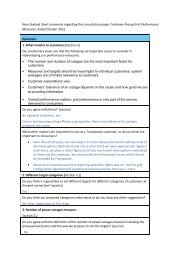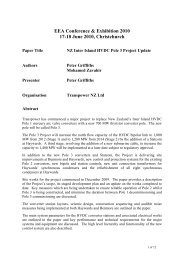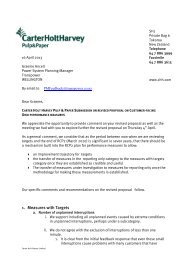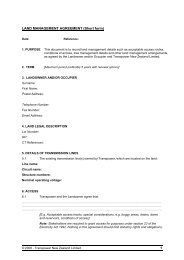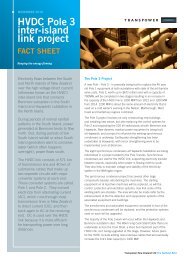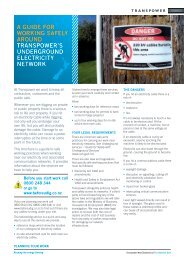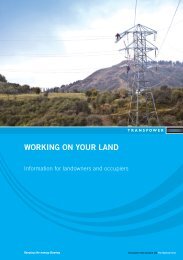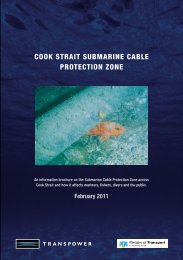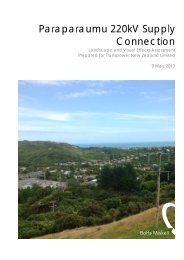8 Auckland Regional Plan - Transpower
8 Auckland Regional Plan - Transpower
8 Auckland Regional Plan - Transpower
- No tags were found...
Create successful ePaper yourself
Turn your PDF publications into a flip-book with our unique Google optimized e-Paper software.
Chapter 8: <strong>Auckland</strong> RegionThe <strong>Auckland</strong> region has some of the highest load densities in New Zealand, coupledwith relatively low levels of local generation.We have assessed the <strong>Auckland</strong> region’s transmission needs over the next 15 yearswhile considering longer-term development opportunities. Specifically, thetransmission network needs to be flexible to respond to a range of future service andtechnology possibilities, taking into consideration:the existing transmission networkforecast demandforecast generationequipment replacement based on condition assessment, andpossible technological development.8.2 <strong>Auckland</strong> transmission systemThis section highlights the state of the <strong>Auckland</strong> regional transmission network. Theexisting transmission network is set out geographically in Figure 8-1 andschematically in Figure 8-2.Figure 8-2: <strong>Auckland</strong> transmission schematicNORTHLANDHenderson Hepburn RoadVECTOR CBD22 kVVECTOR CBD33 kVPenrose220 kV110 kVMount Roskill22 kV110 kVSouthdownPakuranga220 kV33 kV220 kVSCKEY220kV CIRCUIT110kV CIRCUITSUBSTATION BUSTRANSFORMERTEE POINTLOADMangere33 kV 110 kV220 kV110 kVOtahuhuCombinedCycleWiriSCOtahuhu110 kV22 kV220 kVCAPACITORUNDERGROUND CABLEBONDED CIRCUIT33 kV110 kV110 kVSCSYNCHRONOUS CONDENSER33 kVGENERATORTakaniniBombayGlenbrook33 kV 220 kV33 kV 220 kVDrury220 kVHuntlyWAIKATOOhinewai Whakamaru Arapuni HamiltonWAIKATO2012 Annual <strong>Plan</strong>ning Report © <strong>Transpower</strong> New Zealand Limited 2012. All rights reserved. 107
Chapter 8: <strong>Auckland</strong> Region8.2.1 Transmission into/through the regionAs approximately 70% of the <strong>Auckland</strong> and Northland regions’ peak electricitydemand is supplied by generation located south of Bombay, transmission isnecessary to keep the energy flowing into <strong>Auckland</strong> and through to North <strong>Auckland</strong>and the Northland region.There are three major projects and a series of small projects that we are progressingto ensure that the <strong>Auckland</strong> region has secure transmission as demand continues togrow.Broader project descriptions that provide a context for the issues identified in latersections include the:North Island Grid Upgrade (NIGU) projectNorth <strong>Auckland</strong> and Northland (NAaN) grid upgrade project, andUpper North Island Reactive Support (UNIRS) project.North Island Grid Upgrade (NIGU) projectThis committed project includes building a new transmission link into the Pakurangasubstation from the south, operating the existing Otahuhu–Pakuranga line at itsdesign voltage of 220 kV (previously operating at 110 kV), and providing additionalreactive support for the area to maintain voltages in the <strong>Auckland</strong> and Northlandregions (see Chapter 6, Sections 6.3.2 and 6.4.2).This project:provides additional transmission capacity into the <strong>Auckland</strong> region (see Section6.4.2)provides diversity for transmission from the south into the <strong>Auckland</strong> region (allexisting 220 kV transmission circuits terminate into Otahuhu), andconverts Pakuranga from 110 kV to 220 kV, which reduces the load on the110 kV system supplying the eastern side of the <strong>Auckland</strong> region, includingPenrose.North <strong>Auckland</strong> and Northland (NAaN) grid upgrade projectThis committed project adds new transmission capacity between the Pakuranga,Penrose, and Albany substations. It also enables the building of new grid exit pointsat Hobson Street (<strong>Auckland</strong> CBD) and Wairau Road (North Shore). The NAaNproject reinforces transmission in the <strong>Auckland</strong> region and across into the Northlandregion. The 220 kV circuit from Pakuranga to Penrose will:increase capacity to the Penrose 220 kV bus by adding a third 220 kV circuitalongside the existing 220 kV Otahuhu–Penrose double-circuit line, andbuild on the NIGU project by increasing the diversity for transmission from thesouth into the <strong>Auckland</strong> region, as there will be 220 kV transmission fromPakuranga to Otahuhu and Penrose.The 220 kV circuit from Penrose to Albany will:increase capacity to the Northland region (including the North Isthmus) by addinga third 220 kV circuit from Otahuhu to Hendersonbuild on the NIGU project by increasing the diversity for transmission from thesouth into the Northland region (including the North Isthmus), as there will be220 kV transmission from Pakuranga, through Penrose, to Albanyprovide capacity and security to Vector’s Hobson Street and Wairau Roadsubstations through a 220 kV connection to the Albany–Penrose circuit, andenable Vector to redistribute load from existing grid exit points, particularly theAlbany 33 kV and 110 kV (Wairau Road) loads and <strong>Auckland</strong> CBD loads.1082012 Annual <strong>Plan</strong>ning Report © <strong>Transpower</strong> New Zealand Limited 2012. All rights reserved.
Chapter 8: <strong>Auckland</strong> RegionUpper North Island Reactive Support (UNIRS) projectThe purpose of this project is to relieve voltage stability issues associated with anoutage of major generators and/or circuits supplying the Upper North Island area (seeChapter 6). It includes installing dynamic reactive support at Penrose and Marsden.8.2.2 Transmission and distribution network within the regionThe <strong>Auckland</strong> transmission network consists of three layers: the 220 kV network,the 110 kV network, and the 110 kV distribution system belonging to the local linescompany, Vector.220 kV transmission networkThe 220 kV network supplies Otahuhu from the south, via a double-circuit line fromHuntly, a double-circuit line from Whakamaru via Ohinewai, and two single-circuitlines from Whakamaru.At Otahuhu the 220 kV network splits into two with one network supplying Penrosevia a double-circuit line, and the other network supplying the Northland region(including the North Isthmus) via a second double-circuit line to Henderson.The commissioning of a new 220 kV substation at Otahuhu (physically separatedfrom the existing switchyard) provides physical diversity, making the power supplymore resilient for rare but high-impact disturbances.110 kV transmission networkThe 110 kV transmission network is split into two parts.One half of the 110 kV network is a backup supply to Penrose, in parallel with the220 kV Otahuhu–Penrose double circuit line, with 220/110 kV interconnectors atOtahuhu and Penrose. The 110 kV system also connects to the Waikato regionby a Bombay–Wiri–Otahuhu double-circuit line, with power flow generally southout of Otahuhu.The other half of the 110 kV network supplies Mangere and Mount Roskill in adouble-circuit ring, extending from Mount Roskill through a double-circuit 110 kVconnection to substations in the Northland region (at Henderson and Albany).There are 220/110 kV interconnections at Otahuhu, Henderson, and Albany,making the 110 kV network parallel with the 220 kV Otahuhu–Henderson doublecircuitline. Power flow is generally into Mount Roskill on all circuits, from bothOtahuhu and the Northland region.110 kV distribution systemVector’s 110 kV distribution system connects from Penrose to Mount Roskill viaVector’s Liverpool Street substation, and is normally split between Mount Roskill andLiverpool Street. However, it is often used to transfer the Liverpool Street load (up to90 MW) between the Penrose and Mount Roskill substations.8.2.3 Reactive powerTo improve the network voltage and voltage stability, static capacitors are installed atthe Otahuhu, Penrose, and Bombay substations. Condensers at Otahuhu providedynamic reactive power under contract.8.2.4 Longer-term development pathWe have identified a longer-term development path to address issues involvingtransmission into, within and through the <strong>Auckland</strong> region, the details of which will berevisited when the need arises. The timing of the transmission investments dependson the net load of the <strong>Auckland</strong> and Northland regions. New generation in the region2012 Annual <strong>Plan</strong>ning Report © <strong>Transpower</strong> New Zealand Limited 2012. All rights reserved. 109
Chapter 8: <strong>Auckland</strong> Regionor demand-side response may defer transmission investment. Similarly, regionalgeneration retirement or increased demand will bring forward the need fortransmission investment.Possible future upgrades include, but are not limited to the following:Installation of series compensation on the 220 kV Pakuranga–Whakamarucircuits to improve load sharing with the other 220 kV circuits. Ultimately, theBrownhill–Whakamaru section of the Pakuranga–Whakamaru circuits will beupgraded to operate at 400 kV, by installing 400/220 kV transformers at Brownhilland Whakamaru.Increasing the transfer capacity into <strong>Auckland</strong> by building a switching station atBrownhill and cable circuits from Brownhill to Otahuhu.Possibly increasing the capacity of the 110 kV circuits between Arapuni andOtahuhu via thermal upgrades or re-conductoring with higher-capacityconductors.Transmission reinforcement within the <strong>Auckland</strong> region via additional cablesbetween Pakuranga, Penrose, and Mount Roskill.Transmission reinforcement into the Northland region via a second cablebetween Penrose and Albany.Additional static and dynamic reactive power support approximately every 2 to 3years to ensure power system voltage stability, and sufficient reserves aremaintained to cover the worst transmission contingency. The seriescompensation on the 220 kV Pakuranga–Whakamaru circuits may be broughtforward because of its positive contribution to voltage stability and reduction intransmission losses.Beyond the next 30 years, new transmission capacity may be required into <strong>Auckland</strong>,which can be provided by a new 400 kV line, an HVDC link or refurbishment of theexisting lines.The development of the <strong>Auckland</strong> spatial plan (particularly in the South <strong>Auckland</strong>area) will have a large influence on future options for increasing transmission capacityinto <strong>Auckland</strong>.Figure 8-3 provides an indication of the possible transmission development within andthrough <strong>Auckland</strong> in the longer term (beyond 2027).1102012 Annual <strong>Plan</strong>ning Report © <strong>Transpower</strong> New Zealand Limited 2012. All rights reserved.
Chapter 8: <strong>Auckland</strong> RegionFigure 8-3: Indicative <strong>Auckland</strong> and Northland region schematic beyond 2027VECTOR CBD NETWORKNORTHLANDHendersonHepburn RoadNORTHLANDAlbany / Wairau RoadHobsonStreet110 kV220 kVMVAR110 kV220 kV220 kVPenrose110 kVMountRoskillSouthdown220 kVPakurangaMVAR220 kVKEYMangere110 kV220 kV110 kVOtahuhuCombinedCycleMVAROtahuhu110 kV220 kVNEW ASSETSUPGRADED ASSETSWiri110 kV110 kVBombayBrownhill220 kV400 kVTakaniniHuntlyOhinewaiWhakamaru Arapuni HamiltonWAIKATOWhakamaru8.3 <strong>Auckland</strong> demandThe after diversity maximum demand (ADMD) for the <strong>Auckland</strong> region is forecast togrow on average by 2.1% annually over the next 15 years, from 1,530 MW in 2012 to2,078 MW by 2027. This is higher than the national average demand growth of 1.7%annually.Figure 8-4 shows a comparison of the 2011 and 2012 forecast 15-year maximumdemand (after diversity 48 ) for the <strong>Auckland</strong> region. The forecasts are derived usinghistorical data, and modified to account for customer information, where appropriate.The power factor at each grid exit point is also derived from historical data, and isused to calculate the real power capacity for power transformer and transmission line.See Chapter 4 for more information about demand forecasting.48The after diversity maximum demand (ADMD) for the region will be less than the sum of theindividual grid exit point peak demands, as it takes into account the fact that the peak demand doesnot occur simultaneously at all the grid exit points in the region.2012 Annual <strong>Plan</strong>ning Report © <strong>Transpower</strong> New Zealand Limited 2012. All rights reserved. 111
Chapter 8: <strong>Auckland</strong> RegionFigure 8-4: <strong>Auckland</strong> region after diversity maximum demand forecastLoad (MW)2200<strong>Auckland</strong>2000180016001400120010002011 APR Forecast8002012 APR ForecastActual Peak6001997 1999 2001 2003 2005 2007 2009 2011 2013 2015 2017 2019 2021 2023 2025 2027Table 8-1 lists forecast peak demand (prudent growth) for each grid exit point for theforecast period, as required for the Grid Reliability Report.Table 8-1: Forecast annual peak demand (MW) at <strong>Auckland</strong> grid exit points to 2027Grid exit pointPowerfactorNext 5 yearsPeak demand (MW)5-15 years out2012 2013 2014 2015 2016 2017 2019 2021 2023 2025 2027Bombay 33 kV 1 0.98 25 26 26 27 14 14 14 0 0 0 0Bombay 110 kV 1 1.00 51 52 53 54 69 70 73 90 93 96 98Glenbrook 33 kV 1.00 32 33 33 34 35 35 37 38 39 40 41Glenbrook NZSteel0.99 116 116 120 120 120 120 120 120 120 120 120Hobson Street 2, 3 0.97 0 0 126 130 134 137 144 150 155 161 164Mangere 33 kV 0.94 115 119 122 126 129 133 141 149 155 161 166Mangere 110 kV 0.87 55 55 55 55 55 55 55 55 55 55 55Meremere 4 0.95 14 14 15 15 0 0 0 0 0 0 0Mt Roskill 22 kV 0.98 130 134 138 142 146 151 160 168 175 182 187Mt Roskill 110 kV– Kingsland0.97 66 68 70 72 74 76 80 83 86 89 91Otahuhu 0.99 66 69 71 73 75 77 82 86 91 95 100Pakuranga 0.98 163 167 171 174 178 182 189 196 203 210 218Penrose 22 kV 0.96 50 52 53 55 56 58 62 65 67 70 72Penrose 33 kV 0.98 300 309 318 328 338 348 369 388 403 420 432Penrose 110 kV -3 0.97 238 246 126 130 134 137 144 150 155 161 164Liverpool StreetPenrose 110 kV- Quay Street 5 NA 0 0 0 0 0 0 0 0 0 0 0Takanini 6 0.99 125 129 133 137 141 145 154 162 168 175 180Wiri 0.99 82 85 87 90 92 95 101 106 110 115 1181122012 Annual <strong>Plan</strong>ning Report © <strong>Transpower</strong> New Zealand Limited 2012. All rights reserved.
Chapter 8: <strong>Auckland</strong> RegionGrid exit pointPowerfactorNext 5 yearsPeak demand (MW)5-15 years out2012 2013 2014 2015 2016 2017 2019 2021 2023 2025 20271. The customer advised that approximately half of the load will shift from Bombay 33 kV to Bombay110 kV in 2016, with the balance of the load shifting in 2020.2. A new grid exit point at Hobson Street is planned to be commissioned in 2013/2014. Some of thePenrose–Liverpool Street load will be transferred to Hobson Street.3. The 50/50 load split between Hobson Street and Penrose–Liverpool Street is an estimate only.Paralleling of the Vector and <strong>Transpower</strong> networks between these grid exit points is beingconsidered.4. The customer advised that the load at Meremere will be shifted to Huntly (in the Waikato region) in2016.5. The Penrose 110 kV–Quay Street load has been transferred to Penrose–Liverpool Street and thePenrose–Quay Street circuits decommissioned.6. The customer advised that their forecast is lower than <strong>Transpower</strong>’s forecast.8.4 <strong>Auckland</strong> generationThe <strong>Auckland</strong> region’s generation capacity is approximately 681 MW.Table 8-2 lists the generation forecast for each grid injection point for the forecastperiod, as required for the Grid Reliability Report. This includes all known andcommitted generation stations including those embedded within the relevant locallines company’s network (Vector or Counties Power). 49No new generation is known to be committed in the <strong>Auckland</strong> region for the forecastperiod.Table 8-2: Forecast annual generation capacity (MW) at <strong>Auckland</strong> grid injection points to2027 (including existing and committed generation)Grid injection point(location if embedded)Next 5 yearsGeneration capacity (MW)5-15 years out2012 2013 2014 2015 2016 2017 2019 2021 2023 2025 2027Glenbrook 1 112 112 112 112 112 112 112 112 112 112 112Mangere (WatercareMangere)7 7 7 7 7 7 7 7 7 7 7Otahuhu B CCGT 380 380 380 380 380 380 380 380 380 380 380Otahuhu(Greenmount Landfill)Penrose (<strong>Auckland</strong>Hospital)5 5 5 5 5 5 5 5 5 5 54 4 4 4 4 4 4 4 4 4 4Southdown CCGT 170 170 170 170 170 170 170 170 170 170 170Takanini(Whitford Landfill)3 3 3 3 3 3 3 3 3 3 31. This is a 38 MW embedded generating unit with a continuous output rating of approximately 25 MW.8.5 <strong>Auckland</strong> significant maintenance workOur capital project and maintenance works are integrated to enable system issues tobe resolved if possible when assets are replaced or refurbished. Table 8-3 lists thesignificant maintenance-related work 50 proposed for the <strong>Auckland</strong> region for the next15 years that may significantly impact related system issues or connected parties.4950Only generators with capacity greater than 1 MW are listed. Generation capacity is rounded to thenearest megawatt.This may include replacement of the asset due to its condition assessment.2012 Annual <strong>Plan</strong>ning Report © <strong>Transpower</strong> New Zealand Limited 2012. All rights reserved. 113
Chapter 8: <strong>Auckland</strong> RegionTable 8-3: Proposed significant maintenance workDescriptionBombay supply transformersexpected end-of-life, and 33 kVoutdoor to indoor conversionTentativeyear2018-20202016-2018Related system issuesBombay supply transformer capacities are sufficient forthe forecast period. The customer may relinquish33 kV supply from Bombay within 10-20 years.Mangere 33 kV outdoor toindoor conversionMount Roskill supplytransformer T3 expected end-oflife,and 22 kV outdoor to indoorconversionOtahuhu interconnectingtransformer expected end-of-lifeOtahuhu supply transformersexpected end-of-lifePenrose T10 interconnectingtransformer expected end-of-life2014-2016 The forecast load will exceed the transformer n-1capacity from 2012. The n-1 capacity is limited byprotection limit. If appropriate, the work to resolve thislimit will be coordinated with the 33 kV outdoor to indoorconversion work. See Section 8.8.5 for moreinformation.2015-2019 The Mount Roskill load is forecast to exceed thetransformer n-1 capacity from 2012. The n-1 capacity islimited by a few branch components initially, and thenthe transformers need a capacity upgrade by 2020 tomeet n-1 capacity. See Section 8.8.6 for moreinformation.2019-2021 The options to replace the transformers must becoordinated with the:Penrose T10 interconnecting transformer replacement –see Section 8.8.3 for more informationOtahuhu–Wiri transmission capacity issue – see Section8.8.8 for more information, andOtahuhu–Penrose 110 kV transmission capacity issue –see Section 8.8.102021-2023 The Otahuhu load already exceeds the transformers’n-1 capacity. See Section 8.8.7 for more information.2017-2019 This work will be coordinated with the Otahuhuinterconnecting transformer replacement. See Section8.8.3 for more information.Penrose supply transformersexpected end-of-life, and 33 kVoutdoor to indoor conversion2026-20282012-2014A spare transformer enables us to manage the existingthree supply transformers for the next 15 years. See8.8.11 for more informationTakanini 33 kV outdoor toindoor conversionWiri supply transformerexpected end-of-life and 33 kVoutdoor to indoor conversion2014-2016 Takanini supply transformer n-1 capacity is limited by afew transformer branch component limits. Ifappropriate, the work to resolve these limits will becoordinated with the 33 kV outdoor to indoor conversionwork. See Section 8.8.12 for more information.2014-2017 The Wiri load is forecast to exceed the transformer n-1capacity by 2019. See Section 0 for more information.8.6 Future <strong>Auckland</strong> projects summary and transmission configurationTable 8-4 lists projects to be carried out in the <strong>Auckland</strong> region within the next 15years.Figure 8-5 shows the possible configuration of <strong>Auckland</strong> transmission in 2027, withnew assets, upgraded assets, and assets undergoing significant maintenance withinthe forecast period.Table 8-4: Projects in the <strong>Auckland</strong> region up to 2027Site Projects StatusAlbany–Penrose 220 kV cables between Albany and Penrose. CommittedBrownhill –WhakamaruBrownhill–Pakuranga400 kV capable double-circuit transmission line. Committed220 kV cables between Brownhill and Pakuranga. CommittedBombay Replace 110/33 kV supply transformers. Base Capex1142012 Annual <strong>Plan</strong>ning Report © <strong>Transpower</strong> New Zealand Limited 2012. All rights reserved.
Chapter 8: <strong>Auckland</strong> RegionSite Projects StatusConvert 33 kV outdoor switchgear to an indoor switchboard.Base CapexHobson Street New substation at Hobson Street. CommittedMangereMount RoskillOtahuhuResolve supply transformer protection limits.Convert 33 kV outdoor switchgear to an indoor switchboard.Upgrade supply transformer branch limiting components.Replace Mount Roskill T3 supply transformer.Convert 22 kV outdoor switchgear to an indoor switchboard.Replace Otahuhu T2/T4 interconnecting transformers.Replace 220/22 kV supply transformers.Install a new 220/22 kV supply transformer.Base CapexBase CapexPossibleBase CapexBase CapexBase CapexBase CapexPossibleOtahuhu–Wiri Increase transmission capacity to Wiri. PossibleOtahuhu–PenrosePakuranga–PenrosePenroseTakaniniWiriIncrease the circuit’s capacity.Install 220 kV cable between Pakuranga and Penrose.Install a new +/- 40 Mvar STATCOM at 33 kV bus.Replace Penrose T10 interconnecting transformer.Replace 220/33 kV supply transformer.Convert 33 kV outdoor switchgear to an indoor switchboard.Upgrade supply transformer branch limiting components.Convert 33 kV outdoor switchgear to an indoor switchboard.Resolve supply transformer’s protection limits.New or upgrade the existing supply transformers’ capacity.Convert 33 kV outdoor switchgear to an indoor switchboard.PossibleCommittedCommittedBase CapexBase CapexBase CapexPossibleBase CapexBase CapexPossibleBase Capex2012 Annual <strong>Plan</strong>ning Report © <strong>Transpower</strong> New Zealand Limited 2012. All rights reserved. 115
Chapter 8: <strong>Auckland</strong> RegionFigure 8-5: Possible <strong>Auckland</strong> transmission configuration in 2027NORTHLANDHenderson Hepburn RoadNORTHLANDAlbany / Wairau RoadHobsonStreet110 kV220 kVVECTOR CBDVECTOR CBDVECTOR CBD22 kV33 kVSTCPenrose110 kV220 kVMount Roskill22 kV*110 kVSouthdown220 kVPakuranga33 kV220 kVMangere220 kV110 kVOtahuhu110 kV22 kVKEYNEW ASSETSUPGRADED ASSETSASSETS SCHEDULEDFOR MAINTENANCEMINOR UPGRADE*Takanini*33 kV 110 kVOtahuhuCombinedCycleWiri *33 kV 110 kV110 kVBombay220 kVBrownhill220 kV33 kV33 kV 220 kVGlenbrookDrury33 kV 220 kV220 kVHuntlyWAIKATOOhinewaiWhakamaruArapuni HamiltonWAIKATOWhakamaru8.7 Changes since the 2011 Annual <strong>Plan</strong>ning ReportTable 8-5 lists the specific issues that are either new or no longer relevant within theforecast period when compared to last year's report.Table 8-5: Changes since 2011IssuesPakuranga supply transformer capacityOtahuhu–Penrose 110 kV transmission capacityBombay transmission securityChangeRemoved. Project to install a third transformercompleted.New issue.Removed. Project to install a 110 kV bus couplercompleted.8.8 <strong>Auckland</strong> transmission capabilityTable 6-2 summarises issues involving the <strong>Auckland</strong> region for the next 15 years.For more information about a particular issue, refer to the listed section number.1162012 Annual <strong>Plan</strong>ning Report © <strong>Transpower</strong> New Zealand Limited 2012. All rights reserved.
Chapter 8: <strong>Auckland</strong> RegionTable 8-6: <strong>Auckland</strong> region transmission issuesSectionnumberIssue<strong>Regional</strong>8.8.1 <strong>Auckland</strong> region voltage quality8.8.2 North <strong>Auckland</strong> and Northland regional transmission security8.8.3 Otahuhu interconnecting transformer capacitySite by grid exit point8.8.4 Hobson Street supply security8.8.5 Mangere supply transformer capacity8.8.6 Mount Roskill supply transformer capacity8.8.7 Otahuhu supply transformer capacity8.8.8 Otahuhu–Wiri 110 kV transmission capacity8.8.9 Penrose 220 kV transmission security8.8.10 Otahuhu–Penrose 110 kV transmission8.8.11 Penrose 33 kV supply transformer capacity8.8.12 Takanini supply transformer capacity8.8.13 Wiri supply transformer capacity8.8.14 Wiri Tee transmission capacity8.8.1 <strong>Auckland</strong> region voltage qualityProject context:UNIRS – Chapter 6, See Section 6.4.1 (UNIRS)IssueAs demand in the <strong>Auckland</strong> and Northland regions grows, regional voltages maydeteriorate to a point where the outage of a 220 kV circuit may cause voltagecollapse.Generation located in the <strong>Auckland</strong> and Northland regions is insufficient to meetreactive demand. Reactive power from non-generation sources such as shuntcapacitors, series capacitors, static synchronous compensators (STATCOM), staticvar compensators (SVC) and condensers is required to ensure the maintenance ofacceptable voltage levels and quality.SolutionWe have a number of projects underway to improve <strong>Auckland</strong> voltage, including aSTATCOM at Penrose and a STATCOM at Marsden. Despite these projects,<strong>Auckland</strong> voltage stability is an ongoing issue requiring continual study as the<strong>Auckland</strong> and Northland regional loads grow.8.8.2 North <strong>Auckland</strong> and Northland regional transmission securityProject context:NAaNProject reference: ALB_PAK-TRAN-DEV-01Project status/purpose: Committed, to meet Grid Reliability Standard (core grid)Indicative timing: Q4 2013Indicative cost band: GIssueThere are three issues with respect to <strong>Auckland</strong> transmission security.2012 Annual <strong>Plan</strong>ning Report © <strong>Transpower</strong> New Zealand Limited 2012. All rights reserved. 117
Chapter 8: <strong>Auckland</strong> RegionNorth <strong>Auckland</strong> and Northland supply can be maintained with n-1 security untilwinter 2016. From that date, further transmission reinforcement or a transmissionalternative will be required.North <strong>Auckland</strong> and Northland load is supplied by a single 220 kV double-circuitoverhead line, leaving this significant load at risk from a double-circuit outage.Vector requires transmission reinforcement in the <strong>Auckland</strong> CBD (Hobson Street)and on the North Shore (Wairau Road, in the Northland region) in 2014 and2013, respectively.SolutionWe have committed to install a 220 kV underground cable link between thePakuranga, Penrose and Albany substations, which:provides security of supply for the North <strong>Auckland</strong> and Northland beyond 2016improves transmission diversity into the North <strong>Auckland</strong> and Northland, andconnects to new grid exit points at Hobson Street and Wairau Road.The link will provide a capacity of approximately 790 MVA (winter). As the cable linkwill have significantly lower impedance than the parallel 220 kV overheadtransmission circuits between Otahuhu, Henderson, and Albany, more power will flowthrough the cable than in the parallel circuits. A series reactor in the cable circuit isincluded to balance the power flow between the parallel routes.8.8.3 Otahuhu interconnecting transformer capacityProject status/purpose:This issue is for information onlyIssueThe Otahuhu 110 kV bus is normally operated split with two separate buses to givebetter load distribution and manage fault levels.There are two pairs of 220/110 kV interconnecting transformers at Otahuhu.One pair (T2 and T4, rated at 100 MVA and 200 MVA, respectively) supplies the110 kV bus section with circuits to Bombay, Penrose and Wiri 110 kV substations,providing:a total nominal installed capacity of 300 MVA, andn-1 capacity of 135/145 MVA (summer/winter).One pair (T3 and T5, rated at 250 MVA each) supplies the 110 kV bus section withcircuits to the Mangere and Mount Roskill 110 kV substations, providing:a total nominal installed capacity of 500 MVA, andn-1 capacity of 318/332 MVA (summer/winter).Otahuhu T2 and T4 are effectively in parallel with the Penrose T6 and T10interconnecting transformers through the Otahuhu–Penrose transmission system.Toward the end of the forecast period, the T2 transformer may exceed its postcontingencycapacity at peak load times for an outage of the T4 transformer.SolutionThe recent conversion of Pakuranga from 110 kV to 220 kV reduced the load onOtahuhu T2 and T4, and Penrose T6 and T10 transformers. These transformers nowhave sufficient capacity until the <strong>Auckland</strong> CBD load reaches approximately 300 MW.This is likely to occur in the second half of the forecast period or beyond. Any loadpermanently transferred to Hobson Street will also reduce the loading on theinterconnecting transformers at Otahuhu and Penrose.1182012 Annual <strong>Plan</strong>ning Report © <strong>Transpower</strong> New Zealand Limited 2012. All rights reserved.
Chapter 8: <strong>Auckland</strong> RegionAdditionally, the Otahuhu T2, T4 and Penrose T10 interconnecting transformers havean expected end-of-life within the forecast period. We will investigate the number andratings for the replacement interconnecting transformers.8.8.4 Hobson Street supply securityProject context:NAaNProject reference: HOB-SUBEST-DEV-01Project status/purpose: Committed, customer-specificIndicative timing: 2014Indicative cost band: D (including an initial 250 MVA 220/110 kV transformer)IssueVector has indicated that to ensure security of supply, it requires reinforcement of itsHobson Street substation by 2014.SolutionA new 220/110 kV grid exit point will be built at Hobson Street connecting to the newAlbany–Penrose cable (see Section 8.8.2). This will also allow Vector to transfersome load from the Penrose 110 kV grid exit point.8.8.5 Mangere supply transformer capacityProject reference: MNG-POW_TFR_PTN-01Project status/purpose: Base Capex, minor enhancementIndicative timing: 2012Indicative cost band: AIssueTwo 110/33 kV transformers supply Mangere’s load, providing:a total nominal installed capacity of 240 MVA, andn-1 capacity of 118/118 MVA 51 (summer/winter).The peak load at Mangere is forecast to exceed the transformers’ n-1 winter capacityby 5 MW in 2012, increasing to approximately 56 MW in 2027 (see Table 8-7).Table 8-7: Mangere supply transformer overload forecastGrid exitpointPowerfactorNext 5 yearsTransformer overload (MW)5-15 years out2012 2013 2014 2015 2016 2017 2019 2021 2023 2025 2027Mangere 0.94 5 9 12 16 20 24 32 39 45 51 56SolutionWe will discuss options with Vector. Possible solutions include:resolving the protection limit of the transformers which will solve the overloadissue until 2018, orlimiting the peak load to the transformer capacity, with future load growthtransferred to other grid exit points.Future development options to increase transformer capacity for this grid exit pointwill be customer driven.51The transformers’ capacity is limited by a protection equipment limit; with this limit resolved, the n-1capacity will be 138/144 MVA (summer/winter).2012 Annual <strong>Plan</strong>ning Report © <strong>Transpower</strong> New Zealand Limited 2012. All rights reserved. 119
Chapter 8: <strong>Auckland</strong> RegionIn addition, we also plan to convert the Mangere 33 kV outdoor switchgear to anindoor switchboard within the next five years.8.8.6 Mount Roskill supply transformer capacityProject reference: ROS-POW_TFR-EHMT-01Project status/purpose: Possible, customer-specificIndicative timing: 2015Indicative cost band: AIssueThree 110/22 kV transformers (one rated at 50 MVA and two at 70 MVA each) supplyMount Roskill’s load, providing:a total nominal installed capacity of 190 MVA, andn-1 capacity of 140/141 MVA 52 (summer/winter).The peak load at Mount Roskill is forecast to exceed the transformers’ n-1 wintercapacity by 1 MW in 2012, increasing to 58 MW in 2027 (see Table 8-8).Table 8-8: Mount Roskill supply transformer overload forecastGrid exitpointPowerfactorNext 5 yearsTransformer overload (MW)5-15 Years out2012 2013 2014 2015 2016 2017 2019 2021 2023 2025 2027Mount Roskill 0.98 1 5 9 13 17 21 31 39 46 53 58SolutionWe will investigate removing the transformers’ circuit breaker and protection relayconstraints. This will increase the n-1 capacity to 145/152 MVA (summer/winter),which is sufficient to delay the issue for several years.The Mount Roskill T3 supply transformer has an expected end-of-life within theforecast period. In addition, we also plan to convert the 22 kV outdoor switchyard toan indoor switchboard within the forecast period.We will discuss the ratings and timing for the replacement transformer with Vector.Further development options to increase transformer capacity for this grid exit pointwill be customer driven.8.8.7 Otahuhu supply transformer capacityProject reference:Project status/purpose:Indicative timing:Indicative cost band:OTA-POW_TFR-EHMT-01New transformer: possible, customer-specificTo be advisedBIssueTwo 220/22 kV transformers supply Otahuhu’s load, providing:a total nominal installed capacity of 100 MVA, andn-1 capacity of 59/59 MVA 53 (summer/winter).5253The transformer’s capacity is limited by a circuit breaker limit on the 50 MVA transformer and relaylimits on the 70 MVA transformers; with auxiliary equipment limits resolved, the n-1 capacity will be145/152 MVA (summer/winter).The transformers’ capacity is limited by LV cable ratings, followed by a transformer bushings limit(64 MVA); with these limits resolved, the n-1 capacity will be 67/71 MVA (summer/winter).1202012 Annual <strong>Plan</strong>ning Report © <strong>Transpower</strong> New Zealand Limited 2012. All rights reserved.
Chapter 8: <strong>Auckland</strong> RegionThe peak load at Otahuhu is forecast to exceed the n-1 winter capacity by 9 MW in2012, increasing to approximately 42 MW in 2027 (see Table 8-9).Table 8-9: Otahuhu supply transformer overload forecastGrid exitpointPowerfactorNext 5 yearsTransformer overload (MW)5-15 years out2012 2013 2014 2015 2016 2017 2019 2021 2023 2025 2027Otahuhu 0.99 9 11 13 16 18 20 24 29 33 38 42SolutionUpgrading the LV cable and removing the bushing constraints on the supplytransformers will not resolve the issue.We will discuss other options with Vector, which include:limiting peak load to the firm transformer capacity, with future load growthtransferred to other grid exit pointsadding a third supply transformer, andreplacing the two existing supply transformers with higher-rated units.Both supply transformers have an expected end-of-life within the forecast period. Wewill discuss the ratings and timing for the replacement transformers with Vector.Further development options to increase transformer capacity for this grid exit pointwill be customer driven.8.8.8 Otahuhu–Wiri 110 kV transmission capacityProject reference:Project status/purpose:Indicative timing:Indicative cost band:OTA_WIR-TRAN-DEV-01Possible, to meet the Grid Reliability Standard (core grid) and/or customerspecificTo be advisedDIssueTwo 110 kV Bombay–Wiri–Otahuhu circuits supply Wiri’s load, with the:Bombay–Wiri section of each circuit rated at 62/76 MVA (summer/winter), andOtahuhu–Wiri section of each circuit rated at 92/101 MVA (summer/winter).Wiri is a double hard tee connection, and an outage of one of the 110 kV Bombay–Wiri–Otahuhu circuits is forecast to overload the Otahuhu–Wiri section of theremaining circuit during summer peak load periods from approximately 2012. Thiswill occur during periods of high <strong>Auckland</strong> generation and low Waikato generation.SolutionWe are investigating several options. In the short-term, Vector can limit Wiri load withfuture load growth transferred to other grid exit points. Possible longer-term optionsare:a new 110 kV cable from Otahuhu connecting to a new 110/33 kV supplytransformer at Wiria new 110/33kV transformer at Otahuhu and a new 33 kV cable connected intoWirireconductoring the 110 kV Otahuhu–Wiri circuits with higher capacity conductor,ora new 220/110 kV connection at Bombay substation on the Huntly–Otahuhucircuit (to reinforce the supply to Wiri from Bombay) and a 110 kV bus at Wiri.2012 Annual <strong>Plan</strong>ning Report © <strong>Transpower</strong> New Zealand Limited 2012. All rights reserved. 121
Chapter 8: <strong>Auckland</strong> RegionSee also the Wiri supply transformer capacity issue (Section 8.8.14).8.8.9 Penrose 220 kV transmission securityProject context:NIGU and UNIRSSee Section 6.4.2 (NIGU project) and Section 8.8.2 (NAaN)IssueThe two 220 kV Otahuhu–Penrose circuits are rated at 469/492 MVA(summer/winter). During peak demand periods, an outage of one Otahuhu–Penrosecircuit may cause the other circuit to exceed the conductor rating from 2013.SolutionIn the short term, the loading on the 220 kV Otahuhu–Penrose circuits may bereduced following an outage by taking the low impedance Penrose 220/110 kVtransformer (T10) out of service. 54 This transfers some of the load to the 110 kVOtahuhu–Penrose 2 circuit. This solution is sufficient until 2014.We are committed to installing a 220 kV Pakuranga–Penrose cable circuit as part ofthe NAaN project, scheduled for completion in 2013 (see Section 8.8.2). This willaddress the issue until approximately 2027 or beyond, when a second 220 kVPakuranga–Penrose circuit will be required.8.8.10 Otahuhu–Penrose 110 kV transmission capacityProject reference:Project status/purpose:Indicative timing:Indicative cost band:OTA_PEN-TRAN-DEV-01Possible, to meet Grid Relilability Standard (not core grid)To be advisedTo be advisedIssueThe 110 kV Otahuhu–Penrose circuit is rated at 177/195 MVA (summer/winter). Aftercommissioning of the NIGU project, an outage of the Penrose 220/110 kVtransformer (T10) will cause the 110 kV Otahuhu–Penrose circuit to overload from2020.SolutionThe Otahuhu–Penrose 110 kV circuit is limited by the terminal spans at Otahuhu andPenrose substations. With this limit removed, the circuit rating is 191/210 MVA,which will delay the issue in the short term.Longer-term solutions include:replacing the old Otahuhu T2 and T4 interconnecting transformers with higherimpedance transformersthermally upgrading the circuit to a higher temperature, orreplacing the circuit with a higher capacity conductor.8.8.11 Penrose 33 kV supply transformer capacityProject status/purpose:This issue is for information only54The two existing Penrose 220/110 kV interconnecting transformers are 200 MVA 5% impedance and250 MVA 15% impedance units. By switching the 5% impedance transformer out of service, thehigher impedance unit will balance the power flow between the remaining 220 kV and the existing110 kV circuits.1222012 Annual <strong>Plan</strong>ning Report © <strong>Transpower</strong> New Zealand Limited 2012. All rights reserved.
Chapter 8: <strong>Auckland</strong> RegionIssueThree 220/33 kV transformers (two rated at 200 MVA and one at 160 MVA) supplyPenrose’s load, providing:a total nominal installed capacity of 560 MVA, andn-1 capacity of 429/450 MVA (summer/winter).The peak load at Penrose is forecast to exceed the transformers’ n-1 winter capacityby approximately 28 MW in 2012, increasing to approximately 183 MW in 2027 (seeTable 8-10).Table 8-10: Penrose supply transformer overload forecastGrid exitpointPowerfactorNext 5 yearsTransformer overload (MW)5-15 years out2012 2013 2014 2015 2016 2017 2019 2021 2023 2025 2027Penrose 0.98 28 39 50 61 72 84 109 131 149 168 183SolutionWe are discussing future development options for this connection point with Vector.It is expected that the peak load will be limited to the firm transformer capacity, withfuture load growth transferred to other grid exit points.We have installed a fourth 220/33 kV supply transformer. This is a system sparetransformer to enable us to manage outages on the existing three supplytransformers for the next 15 years (in particular, allowing the existing T9 transformerto undergo extensive preventative maintenance). The firm capacity will not increase,because only three of the four transformers can be in service to maintain fault levelswithin the equipment ratings.Additionally, we also plan to convert the Penrose 33 kV outdoor switchyard to anindoor switchboard within the forecast period.8.8.12 Takanini supply transformer capacityProject reference: Upgrade protection: TAK-POW_TFR-EHMT-01Upgrade circuit breaker and busbar: TAK-SUBEST-EHMT-01Project status/purpose: Upgrade protection: Base Capex, minor enhancementUpgrade circuit breaker and busbar: possible, customer-specificIndicative timing: 2014-2016Indicative cost band: Upgrade protection: AUpgrade circuit breaker and busbar: AIssueTwo 220/33 kV transformers supply Takanini’s load, providing:a total nominal installed capacity of 300 MVA, andn-1 capacity limit of 126/126 MVA 55 (summer/winter).The peak load at Takanini is forecast to exceed the transformers’ n-1 winter capacityby 6 MW in 2012, increasing to approximately 61 MW in 2027 (see Table 8-11).55The transformers’ capacity is limited by protection equipment limit, followed by the circuit breaker(137 MVA) and 33 kV bus (137 MVA) limits; with these limits resolved, the n-1 capacity will be188/198 MVA (summer/winter).2012 Annual <strong>Plan</strong>ning Report © <strong>Transpower</strong> New Zealand Limited 2012. All rights reserved. 123
Chapter 8: <strong>Auckland</strong> RegionTable 8-11: Takanini supply transformer overload forecastGrid exitpointPowerfactorNext 5 yearsTransformer overload (MW)5-15 years out2012 2013 2014 2015 2016 2017 2019 2021 2023 2025 2027Takanini 0.99 6 10 14 18 22 26 35 43 49 56 61SolutionIf the protection equipment, circuit breaker, and busbar limits are resolved, thetransformers’ thermal capacity will be sufficient until the second half of the forecastperiod.In addition, the Takanini 33 kV outdoor switchyard will be converted into an indoorswitchboard within the next five years. If appropriate, we will upgrade the transformerbranch limiting components in conjunction with the conversion work.Vector has advised that they expect to keep peak load within the transformers’ n-1capacity for several years. Further development options to increase the transformercapacity for this grid exit point will be customer driven.8.8.13 Wiri supply transformer capacityProject reference: Upgrade protection: WIR-POW_TFR_PTN-EHMT-01Upgrade transformer capacity: WIR-POW_TFR-EHMT-01Project status/purpose: Upgrade protection: Base Capex, minor enhancementUpgrade transformer capacity: possible, customer-specificIndicative timing: Upgrade protection: 2019Upgrade transformer capacity: 2021Indicative cost band: Upgrade protection: AUpgrade transformer capacity: BIssueTwo 110/33 kV transformers supply Wiri’s load, providing:a total nominal installed capacity of 200 MVA, andn-1 capacity limit of 106/106 MVA 56 (summer/winter).The peak load at Wiri will exceed the transformers’ summer n-1 capacity byapproximately 2 MW in 2019, increasing to approximately 20 MW in 2027 (see Table8-12).Table 8-12: Wiri supply transformer overload forecastGrid exitpointPowerfactorNext 5 yearsTransformer overload (MW)5-15 years out2012 2013 2014 2015 2016 2017 2019 2021 2023 2025 2027Wiri 0.99 0 0 0 0 0 0 2 7 12 16 20SolutionResolving the protection equipment limits will delay the overload until 2020. We willdiscuss future supply options with Vector, including:limiting peak load to the firm transformer capacity (i.e. 106/106 MVA), with futureload growth transferred to other grid exit points, and/orreplacing the existing transformers with two 120 MVA units, orinstalling a third supply transformer.56The transformers’ capacity is limited by protection equipment limit; with this limit resolved, the n-1capacity will be 109/115 MVA (summer/winter).1242012 Annual <strong>Plan</strong>ning Report © <strong>Transpower</strong> New Zealand Limited 2012. All rights reserved.
Chapter 8: <strong>Auckland</strong> RegionThe solution to the Otahuhu–Wiri transmission capacity issue may also address theWiri supply transformer capacity issue (see Section 8.8.8).The Wiri single phase supply transformers have an expected end-of-life within thenext five years. In addition, we also plan to conver the Wiri 33 kV outdoor switchyardto an indoor switchboard within the next five years.We will discuss with Vector the number, rating, and timing of the transformerreplacement in conjunction with the transformer upgrade and 33 kV outdoor to indoorswitchyard conversion work.Any future transformer upgrade will be customer driven.8.8.14 Wiri Tee transmission capacityProject status/purpose:This issue is for information onlyIssueWiri is connected to the Bombay–Wiri–Otahuhu circuits through the Wiri Tee circuitsections, each rated at 92/101 MVA (summer/winter).The peak load at Wiri already exceeds the circuits’ n-1 summer capacity.SolutionThis issue arises along with the Otahuhu–Wiri circuit issue (see Section 8.8.8). It isexpected to be resolved with that issue. Although the Wiri Tee section is onlyapproximately 90 m in length, it crosses over a motorway, which is expected tocomplicate an otherwise a relatively minor project to increase this circuit section’scapacity.8.9 Other regional items of interestThere are no other items of interest identified to date beyond those set out inSection 8.8. See Section 8.10 for more information about specific generationproposals relevant to this region.8.10 <strong>Auckland</strong> generation proposals and opportunitiesThis section details relevant regional issues for selected generation proposals underinvestigation by developers and in the public domain, or other generationopportunities.The maximum generation that can be connected at any substation depends onseveral factors and usually falls within a range. Generation developers shouldconsult with us at an early stage of their investigations to discuss connection issues.See our website for more information about connecting generation. 578.10.1 Maximum regional generationThe <strong>Auckland</strong> region has some of the highest load densities in New Zealand, coupledwith relatively low levels of local generation, and so there is no practical limit to themaximum generation that can be connected within the region. However, there will belimits on the maximum generation that can be connected at a substation or along anexisting line due to the rating of the existing circuits.57http://www.transpower.co.nz/connecting-new-generation.2012 Annual <strong>Plan</strong>ning Report © <strong>Transpower</strong> New Zealand Limited 2012. All rights reserved. 125
Chapter 8: <strong>Auckland</strong> Region8.10.2 <strong>Auckland</strong> generation issuesThere are numerous inter-related issues with supplying the load within the <strong>Auckland</strong>region, as discussed earlier in this chapter. In addition, the increase in fault level dueto generators will be an issue for some parts of the transmission and/or distributionsystems.Therefore, depending on its connection point, new generation within the <strong>Auckland</strong>region may assist in addressing an issue, make it worse, have no effect, or mayrequire specific additional transmission investment to enable connection. Fault-levelissues may also preclude new generation connection in some locations.1262012 Annual <strong>Plan</strong>ning Report © <strong>Transpower</strong> New Zealand Limited 2012. All rights reserved.




